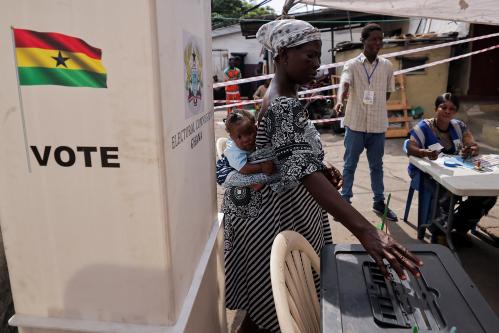With the Federal Reserve embarking on the next phase of its policy normalization, namely the reduction of its balance sheet, the possibility of significant adverse spillovers to emerging market and developing economies (EMDEs) is one of the key risks facing the global economy. Sizeable spillovers from Fed policy tightening in the 1980s and mid-1990s as well as the 2013 taper tantrum episode underscore this risk. In my view, however, the most likely scenario is that EMDEs will experience some adverse effects, but will ultimately manage to avoid systemic financial crises like those of the 1980s and mid-1990s.
First, EMDEs are stronger and better managed now. Since the 1980s and 1990s, EMDE policymakers have made significant strides to lower debt-to-GDP ratios and inflation and reduce economic vulnerabilities, such as excessive reliance on foreign currency or short-term external debt. EMDEs have also accumulated large foreign exchange reserves and enhanced policy frameworks. For example, several countries improved fiscal discipline including, in some cases, enacting fiscal rules. They also adopted stronger monetary policy frameworks like inflation targeting and switched from fixed to more flexible exchange rate regimes. These improvements have bolstered policy credibility, which allows several EMDEs to use fiscal and monetary policies more effectively to stabilize their economies. During the 2008-2009 global financial crisis, the 2011-2012 European crisis, and the 2014 oil price shock, policy space and credibility allowed EMDEs to provide stimulus to cushion these shocks and avoid systemic crises. Since then, and partly because of policies to manage these shocks, macroeconomic fundamentals have deteriorated a bit. Even so, they remain stronger than a few decades ago and, as a result, EMDEs are more resilient.
Second, since former Governor Ben Bernanke’s time as chairman, the Fed has improved its external communications, including through forward guidance, press conferences, release of Summary of Economic Projections etc., to better align policy actions with expectations of the public and investors. Indicators for market expectations show that the Fed’s policy actions in recent years have generally been more accurately anticipated thereby allowing markets participants to adjust positions less abruptly. This more proactive communication strategy has continued under Chair Janet Yellen’s leadership. The recent release of specific guidance in June on the plan to unwind the Fed’s balance sheet is consistent with the commitment to enhanced communication.
Third, the Fed’s policy normalization is occurring in a context of and in a manner consistent with stronger U.S. economic activity, which provides some support to EMDEs’ exports and economic activity. Admittedly, the Fed’s communication on this point that all the meetings are “live” or that policy actions will be “data dependent” may have become cliché, but that does not make it less true.
What about the 2013 taper tantrum?
Starting in May 2013, in reaction to news that the Fed could soon start reducing policy accommodation, financial conditions in several EMDEs deteriorated as investors withdrew capital; local currencies depreciated, equity prices fell, and bond yields rose. This episode, known as the “taper tantrum,” is cited as recent evidence that EMDEs remain highly vulnerable to Fed policy tightening. My assessment of the taper tantrum episode is consistent with and actually underscores my optimism that EMDEs will likely avoid a systemic crisis.
First, the taper tantrum did not lead to a systemic crisis in EMDEs. Second, the news about Fed policy that triggered the sell-off surprised some market participants who were betting on a longer period of low interest rates. The disruptions during the taper tantrum reflected a better realignment of their expectations of those market participants with the future path of monetary policy. Since then, the Fed has enhanced communication and information gathering to better understand and incorporate expectations of a wider range of investors.
Third, not all EMDEs came under significant stress and even those who did, did not experience crises as a result. The key differentiating factors between the countries that suffered and those that fared better were domestic economic vulnerabilities, notably large current account deficits financed by volatile capital flows. This underscores the need for all EMDEs to foster strong economic fundamentals. Finally, and with the benefit of hindsight, there were some advantages to the taper tantrum episode. It is a reminder that U.S. policy tightening could still have adverse consequences for EMDEs and, importantly, it put pressure on policymakers in EMDEs to address vulnerabilities. Currently, some of the countries that were most affected during the taper tantrum have lower vulnerabilities now than they did then.[1] In addition, the expectations of market participants better aligned with the expected path for monetary policy. Largely as a result, the Fed’s decisions to begin tapering in December 2013 and to subsequently raise the policy rate were not disruptive to EMDEs.
The fact that policy normalization has been very gradual contributed to this benign outcome as well. For this reason, as much as there should be concerns about Fed policy normalization, there should also be concerns about the Fed not tightening policy fast enough. The consequence of falling behind the curve could be more rapid rate increases in the future, which will likely be more disruptive.
Assessing the risks of sizeable severe disruptions
That said, the Fed’s balance sheet reduction is not a well-trodden process and not without risks. While the Fed is committed to making the process as smooth as possible, it cannot predict the effect on long-term interest rates—particularly term premiums—with the same degree of confidence that it can with conventional monetary policy. The process will involve some learning along the way with, understandably, risks of slippage.
Another noteworthy consideration is the course of monetary policy in other advanced economies. Up until recently, the Fed was the only major central bank tightening policy. In July, Canada raised its policy rate for the first time since 2010. The Bank of England (BOE), which was on course to tighten along with the Fed, had delayed doing so to cushion the shock of Brexit. Recent communications out of the BOE as well as the European Central Bank suggest that reduction of policy accommodation could be in the offing. A synchronized reduction of policy accommodation in several advanced economies could push up global interest rates faster than the Fed envisions.
Finally, the Fed’s balance sheet reduction will likely persist over a period during which the institution could experience significant leadership turnover. In addition to three vacant seats on the Board of Governors (to be filled by President Donald Trump), the terms of Ms. Yellen and Mr. Fischer as chair and vice chairman, respectively, expire next year. These changes raise the risk of a significant reconfiguration of the Fed’s leadership with, possibly, consequences for policy continuity.
What can policymakers do to minimize adverse spillovers?
Even with limited risks of systemic crises, Fed policy normalization could put significant stress on EMDEs. Several countries issued large foreign currency debt in the post-global financial crisis era. For example, many African countries tapped into financial markets for the first time, issuing large amounts of sovereign debt. Higher rates and weaker currencies caused by Fed policy tightening could push up debt ratios and debt servicing costs. It is important for policymakers in EMDEs to insure adequately against interest and exchange rate risks. In addition, they continue strengthening macroeconomic fundamentals, preserve or rebuild policy buffers, and remain vigilant in addressing current or emerging vulnerabilities. They should also maintain a well-developed prudential policy toolkit and be prepared, under certain circumstances, to adopt capital flow measures temporarily. Over the medium and long term, developing local financial markets will enhance EMDEs’ resilience to global financial shocks, including those emanating from U.S. monetary policy tightening.
Central banks in advanced economies can also help manage the risk of disruption by continuing to boost communication to minimize policy surprises, by making normalization processes as gradual as possible, and by appropriately incorporating spill back effects—the effects of EMDEs on advanced economies—in their monetary policy frameworks.
Spillovers are inevitable in world in which financial markets are integrated and not all spillovers are unwelcome. They present challenges only when their effects are inconsistent with domestic policy objectives. Fostering the best practices outlined above will go a long way to help EMDEs benefit from positive spillovers while building resilience to the negative ones.
Endnotes
[1] The larger EMDEs most affected included Brazil, India, Indonesia, South Africa, and Turkey. Not all of the improvement in fundamentals for these economies owed to policy actions. For example, the oil price decline of late 2014 helped lower inflation rates in these economies and narrow external imbalances.
The Brookings Institution is committed to quality, independence, and impact.
We are supported by a diverse array of funders. In line with our values and policies, each Brookings publication represents the sole views of its author(s).




Commentary
Spillover of Fed policy normalization to emerging market and developing economies: The case for optimism
September 6, 2017